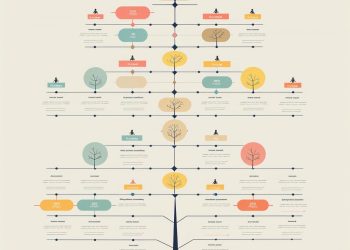Unit 2.2 Organisational Structure
IB Business Management
Charles Handy's "Shamrock Organisation"
The death of the 'job for life'
Shūshin Koyō is Japan’s traditional “job for life” system, where employees remained with a single company until retirement. It featured seniority-based promotions, strong job security, company loyalty, and extensive training. Once a pillar of Japanese corporate culture, it has declined since the 1990s economic downturn, giving way to more flexible employment practices. This system was mirrored (somewhat) in the West where it was common for people to hang on to a job for life!
This has now changed. Charles Handy emphasized the changing nature of work. He recognised that companies need to get workers to fit in with their needs, but also the need to ensure workers are enriching and positive!
What Charles Handy proposed
Handy believed short term contracts were more useful (for both employer and employee). Charles Handy suggested that you can put workers into one of three groups
- Core workers: full time, multi skilled (higher paid) and important
- Peripheral workers: part time and temporary workers. Employed on an ‘as needed basis’, paid piece rate or per hour
- Contract workers: outsourced workers (often specialists) who do important jobs such as advertising, accountancy, training, consultancy etc
You can start to imagine already how this could be both useful for a business and disastrous for employees (and possibly vice versa)



Can Charles Handy help the director of WAW music festivals?
Music festivals are growing in number globally. Festivals vary in location, size, and music genre. They include commercial multiple-day events on farmland and community-led events in public owned parks. Wicked and Wild (WAW) PLC is a European company, has organized music festivals since 20015.
In 2016, WAW converted from a private limited company (Ltd) to a public limited company (PLC) to raise finance for expansion. WAW has 50 permanent employees and also relies on temporary workers and freelancers. WAW organizes six music festivals each year and has contracts with six farmers to use their land for an average fee of $120,000. WAW must clean up after each festival (costing on average $250,000).
WAW’s directors regard environmental issues (CSR) and general sustainability as a big challenge! The festival season is short, starting in May to August. Festivals start on Friday and go through to Sunday. Each festival takes two weeks to create and one week to take down. Each site requires a permiter fence, stages, sound, lights, electricity generation, toilets, water and other specialist infrastructure to allow payments to happen.
Given the nature of the business, WAW’s directors have been wondering if Charles Handy’s Shamrock organisation model could be applied!
With this in mind, the directors sketched out the workers that they have to consider and tried to place them into one of the three categories identified in the Shamrock model
Stage & Lighting Designer
Ticketing & Wristband Checkers
Finance & Budget Analyst
Site Infrastructure Contractor (Fencing, Water, Toilets)
Marketing & PR Coordinator
Sound Engineer
Bar & Catering Staff
Sponsorship & Partnerships Manager
Merchandise Sellers
Health & Safety Officer
Security & Crowd Control Specialist
Website Designer
Waste Management & Clean-Up Crew Leader
Stagehands & Setup Crew
Questions from the WAW case study
- Define Charles Handy’s “Shamrock Organisation” model [2]
- (General discussion question) Examine the list of 16 job roles and place them each into one of the 3 categories identified in Charles Handy’s Shamrock organisation model [10]
- Identify and explain one potential advantage of implementing this model on Wicked and Wild (WAW) [3]
- Identify and explain one potential disadvantage of implementing this model on Wicked and Wild (WAW) [3]
- Evaluate whether or not the benefits of implementing the model outweigh the problems for WAW [6]



ADDITIONAL INFORMATION
Charles Handy’s Shamrock Organization model is based on a flexible approach to organizing and managing a workforce. The model is named after the three-leafed shamrock, representing the three different types of workers in the organization.
1. Short-Term Contracts and Job Enrichment: The Shamrock Organization places a strong emphasis on short-term contracts and job enrichment. Short-term contracts allow organizations to adapt quickly to changing market conditions and demand, fostering agility. Meanwhile, job enrichment focuses on enhancing the quality of work for employees, making their roles more meaningful and satisfying.
2. Flexible Working Patterns: A cornerstone of Handy’s model is the promotion of flexible working patterns. This flexibility accommodates the diverse needs and preferences of employees, contributing to increased job satisfaction and, consequently, higher productivity. The organization benefits from the ability to adjust its workforce based on fluctuating demands.
Three Designations of Workers: Handy identifies three categories of workers.
1 Core Workers:
Core workers are essential, full-time employees crucial to the long-term success and stability of the organization.
They often possess specialized skills and deep institutional knowledge, contributing to the core functions of the business.
2 Peripheral Workers:
Peripheral workers are part-time or temporary employees who provide additional support during peak periods or to address specific projects.
They contribute to the organization’s flexibility by offering expertise in areas that may not require a full-time commitment.
3 Contract Workers:
Contract workers are individuals engaged for short-term projects or specific tasks.
They allow the organization to access specialized skills on a temporary basis, promoting adaptability and cost-effectiveness.
Advantages of Charles Handy’s Shamrock Organisational Model:
Flexibility and Adaptability:
- Advantage: The model allows organizations to quickly adapt to changing market conditions and demands by employing a mix of core, peripheral, and contract workers.
- Advantage: Utilizing peripheral and contract workers as needed can be cost-effective, as organizations only incur labor costs when specific expertise or additional support is required.
Enhanced Productivity:
- Advantage: Job enrichment and flexible working patterns contribute to higher job satisfaction and, subsequently, increased productivity among employees.
Access to Specialized Skills:
- Advantage: Contract workers provide access to specialized skills for short-term projects, allowing the organization to tap into diverse talents without the long-term commitment.
Effective Resource Management:
- Advantage: The Shamrock Model enables efficient resource allocation, aligning the workforce with the organization’s strategic needs at any given time.
Disadvantages of Charles Handy’s Shamrock Organisational Model:
Employee Insecurity:
- Disadvantage: Short-term contracts and the reliance on peripheral and contract workers may lead to job insecurity among employees, affecting morale and commitment.
Reduced Organizational Loyalty:
- Disadvantage: The model’s emphasis on flexibility may result in reduced loyalty from workers, especially peripheral and contract employees, who may not feel as invested in the organization.
Communication Challenges:
- Disadvantage: Coordinating and communicating effectively with a diverse workforce, including core, peripheral, and contract workers, can be challenging, potentially leading to misalignment and misunderstandings.
Potential for Skill Gaps:
- Disadvantage: Depending too heavily on peripheral and contract workers may result in skill gaps within the organization, especially if core workers do not possess the required expertise.
Legal and Regulatory Compliance Issues:
- Disadvantage: Managing the legal and regulatory aspects of employing a diverse workforce with different employment statuses can be complex and may pose compliance challenges.
SUGGESTED ANSWERS TO THE CASE STUDY
- Define Charles Handy’s “Shamrock Organisation” model. [2]
The Shamrock Organisation model, developed by Charles Handy, categorizes a company’s workforce into three distinct groups: Core Workers, Contractual Fringe, and Flexible Workforce. (1 mark)
- Core Workers are permanent, full-time employees who provide expertise and leadership.
- Contractual Fringe consists of specialists or outsourced contractors hired for specific functions.
- Flexible Workforce includes part-time, seasonal, or temporary workers who provide flexibility.
(1 mark for clear definition, 1 mark for identifying the three worker categories)
- Examine the list of 16 job roles and place them into one of the 3 categories identified in Charles Handy’s Shamrock Organisation model. [10]
Here is a suggestion of how the workers could be allocated! Some minor differences can be accepted if the main model or idea is followed!
Core Workers (Full-time, Permanent Staff):
Marketing & PR Coordinator
Finance & Budget Analyst
Sponsorship & Partnerships Manager
Health & Safety Officer
Contractual Fringe (Freelancers & Contractors):
Stage & Lighting Designer
Website Designer
Sound Engineer
Security & Crowd Control Specialist
Site Infrastructure Contractor (Fencing, Water, Toilets)
Waste Management & Clean-Up Crew Leader
Flexible Workforce (Part-time & Temporary):
Ticketing & Wristband Checkers
Bar & Catering Staff
Stagehands & Setup Crew
Merchandise Sellers
On-Site Medical & First Aid Staff
Application & Analysis (for full marks, link to WAW’s festival operations):
- Core workers ensure continuity and strategic decision-making for WAW.
- Contractual fringe allows WAW to access expert skills (e.g., lighting, security) without long-term costs.
- Flexible workforce is crucial for short festival seasons, offering scalability.
(Marks awarded for correct classification and application to WAW)
- Identify and explain one potential advantage of implementing this model on Wicked and Wild (WAW). [3]
Advantage: Cost Efficiency & Flexibility (1 mark)
- Explanation: The Shamrock model allows WAW to maintain a small group of permanent employees while outsourcing specialist roles and using temporary staff for peak periods. This reduces fixed salary costs while ensuring operational flexibility. (1 mark)
- Application to WAW: Given that festivals are seasonal (May–August), relying on flexible and contractual workers prevents unnecessary employment costs during the off-season. (1 mark)
- Identify and explain one potential disadvantage of implementing this model on Wicked and Wild (WAW). [3]
Disadvantage: Lack of Commitment & Quality Control (1 mark)
Explanation: Outsourced and temporary workers may not have the same loyalty or training as core employees, leading to inconsistencies in service quality or delays in execution. (1 mark)
Application to WAW: For example, security or ticketing staff working on short-term contracts might not be as invested in customer satisfaction or safety as full-time employees. (1 mark)
- Evaluate whether or not the benefits of implementing the model outweigh the problems for WAW. [6]
Arguments Supporting Implementation:
- Cost savings: Reducing permanent staff lowers fixed costs, which is crucial given the short festival season.
- Access to specialists: WAW can hire expert sound engineers, stage designers, and security teams without long-term contracts.
- Scalability: The flexible workforce allows WAW to expand or contract its staffing needs based on ticket sales and event size.
Arguments Against Implementation:
- Loss of control: Over-reliance on outsourced workers might reduce accountability (e.g., security risks).
- Training & consistency issues: High staff turnover among part-time workers could impact festival operations.
- Reputation risk: Poor customer service from inexperienced staff could damage WAW’s brand image.
Conclusion:
Overall, the benefits of cost efficiency and flexibility outweigh the disadvantages, as WAW operates in a highly seasonal industry where permanent staff would be costly. However, to mitigate risks, WAW should ensure that contractual and flexible workers receive proper training and incentives for quality performance.
(For full marks: Balanced analysis, clear conclusion, real-world application to WAW)



